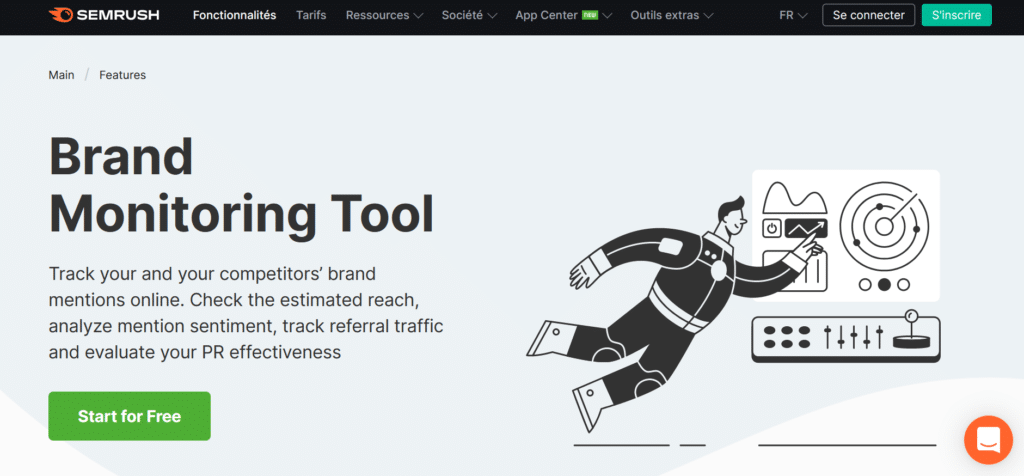4 Best Brand Monitoring Tools in 2024
Hey there, brand guardians! Finding it tough to keep an eye on your brand’s online presence and reputation?
We know the feeling. Did you know that 91% of consumers read online reviews, and 84% trust them as much as personal recommendations?
That’s right – your brand’s online reputation is everything!
We’ve compiled a list of the best brand monitoring tools to help you stay on top of your brand’s digital footprint.
Ready to protect your brand’s image like a pro? Let’s dive in!
What Are Unlinked Brand Mentions?
Unlinked brand mentions are when your brand is mentioned on a public website, but there is no link back to your website.
Although Google gives weight to the unliked brand mention, links offer far greater SEO value as the first off-page ranking signal.
Therefore, when we notice an unlinked reference, we want to act. And when it comes to unlinked brand mentions, an effective option is to ask for the link.
Given that they’ve already cited your brand, it’s safe to assume that the source authors appreciate your product, service, or viewpoint and want to share it with their audience. This puts you in a good position to ask for the icing on the cake = the backlink 🍰
The Unlinked Mention’s Rules
💡 #1 Know advanced search commands inside and out.
It is strongly suggested that you learn to use advanced operators for this approach and others.
💡 #2 There are more keywords than just the brand itself.
To make your searches work, you must discover other terms that will appear on the page where an unlinked brand mention appears. Think of additional words on the website that could restrict your search apart from the brand name.
💡 #3 Stay away from press releases.
Frequently, news releases are sent by major organizations; they are automatically posted to a website and are not editable.
💡 #4 An apparent tip, but it should be stated: avoid negative marketing.
You don’t want to start the conversation with a blogger who dislikes your brand. This may get viral seriously rather than well.
Step 1: Uncover Unlinked Brand Mentions
You might argue it’s easy to say but difficult to accomplish. It all depends on the approach you choose…
THE EASY WAY (🤩)
We recommend unlinked mentions search tools to save time and obtain a more accurate snapshot of your mentions and the individuals or sites discussing your brand.
It only takes one click to find all of your unlinked mentions.
THE HARD WAY
Do the task without using any software; you only need to search the internet for everything written about your business.
For the job, you can rely on Google, the all-knowing omnipotent. This would imply using advanced Google search operators to discover your mentions, followed by additional searches to determine whether or not specific mentions are linked.
Good luck with that 😵
Recommended reading: Top 150K Best Software For Businesses
Further reading
Top Brand Mention Monitoring Software
Google Alerts is a free and straightforward brand monitoring tool that helps users stay informed about online mentions of specific keywords or phrases. Key benefits include:
- Easy setup: Enter keywords or phrases, choose the frequency of alerts, and specify the source type for monitoring.
- Customizable alerts: Tailor alerts to focus on specific regions, languages, and sources, ensuring relevant results.
- Cost-effective: Google Alerts is free, making it accessible for businesses of all sizes.
- Email notifications: Receive notifications directly in your inbox for seamless tracking and quick response.
- Stay informed: Monitor competitors, industry trends, and brand mentions to make informed business decisions.
💡 Pro tip: You can use these to determine where your rivals are referenced. Or to check where your name is being discussed. Or even discover which websites discuss keywords and subjects connected to your company.

2.
Mention is a powerful brand monitoring tool that tracks online conversations about your brand, products, and competitors. Key benefits include:
- Real-time monitoring: Get instant notifications of brand mentions across social media, news, blogs, and websites.
- Competitor analysis: Track your competitors to gain insights, compare performance, and stay ahead.
- Sentiment analysis: Understand the tone of conversations surrounding your brand and gauge customer sentiment.
- Influencer identification: Discover influencers in your industry to collaborate and amplify your marketing efforts.
- Customizable reports: Generate insightful reports and analytics that help make informed decisions for your brand.

3.
Semrush is a versatile brand monitoring tool that helps track and analyze your online presence and competition. Key benefits include:
- Keyword research: Identify profitable keywords and optimize your content for better search engine visibility.
- Competitor analysis: Monitor and analyze your competitors’ strategies to stay ahead in your industry.
- Backlink analysis: Understand your backlink profile, find opportunities for link building, and improve your site’s authority.
- Site audit: Identify and fix on-site issues to improve your website’s performance and SEO.
- Brand monitoring: Track mentions of your brand across the web, find influencers, and gauge sentiment to protect and enhance your brand reputation.

4.
BuzzSumo is a powerful brand monitoring tool focusing on content discovery and social media insights. Key benefits include:
- Content research: Discover the most shared and trending content across various topics and industries to inform your content strategy.
- Competitor analysis: Analyze your competitors’ content performance to uncover strategies that work for your niche.
- Influencer identification: Find and connect with influential people in your industry to amplify your brand’s reach.
- Brand monitoring: Track your brand mentions and sentiment across social media and the web to stay informed about your brand’s reputation.
- Social media insights: To optimize your marketing efforts, understand which content formats and channels work best for your audience.
💡 Pro tip: we recommend starting with your business’s name. You may also search for any significant persons (for example, your company’s founder), software, or services your brand offers to uncover overlooked possibilities for a backlink to your site.

Step 2: Reach Out to the Author of the Mention and Request a Link
Now that you’ve learned how to access your brand mentions, it’s time to turn unlinked mentions into links. First of all, look for your reference writers. They are the people that can help you significantly.
You will also have a better chance of receiving a high-quality link and a long-term relationship if you spend time with the writers before writing them or help them with anything.
Bonus: Advice on outreach
Avoid using the word “backlink.”
When discussing link development with your coworkers, you may always refer to a hyperlink as a link, but for some, the term “link” appears to be associated with spam. Prefer terms like “mention of our website,” “reference to our website,” or “adding of our web address.” It is far more effective than the term “link.”
Provide more details.
When writing the first communication, remind the recipient that if they are not persuaded of relevance in the first round, they may ask you for further details.
Extend the possibility of collaborating with the site.
Popular websites with a lot of authority may seek more authors or specialists. Even if they decline your link request, look for alternatives that could result in a link.
What is link reclamation?
Link reclamation is finding brand mentions and converting them into links. This technique should be an essential component of your digital public relations effort. You’ll always be on the lookout for mentions of your brand name or anything linked to your brand, and if there’s no hyperlink, you’ll email the editor or site owner to request one.
Conclusion
And that’s a wrap – our top picks for the best brand monitoring tools to help you track your brand’s online presence, reputation, and consumer sentiment.
Remember, managing your brand’s online reputation is crucial for building trust and fostering a positive image.
So, take the time to explore these fantastic tools and find the one that perfectly fits your brand monitoring needs.
Wishing you a solid online presence and happy brand monitoring!
FAQs
Brand monitoring tools are software solutions that help businesses track and analyze online mentions and conversations about their brand, products, or services. These tools enable companies to gain insights into customer sentiment, monitor competitor activities, identify potential issues, and uncover opportunities to improve brand reputation and engagement.
Organizations need brand monitoring tools to stay informed about their online presence, understand customer opinions, and respond to potential issues promptly. By monitoring online conversations, businesses can identify trends, manage their reputation, track the effectiveness of marketing campaigns, and gain insights into their target audience.
Critical features of brand monitoring tools include:
• Real-time monitoring: Tracks brand mentions and conversations across various online platforms, such as social media, news websites, blogs, and forums, in real-time.
• Sentiment analysis: Analyzes the sentiment behind online mentions to determine whether they are positive, negative, or neutral.
• Competitor tracking: Monitors competitor activities and compares their online presence and reputation to your brand.
• Alert notifications: Sends notifications when new mentions or significant changes in sentiment occur, allowing for timely responses.
• Reporting and visualization: Generates reports and visualizations that help users understand their brand’s online presence and identify trends, patterns, and areas for improvement.
• Integration capabilities: Seamlessly integrates with other tools and systems, such as CRM, social media management platforms, and analytics tools.
The best brand monitoring tools include Mention, Brand24, Awario, Talkwalker, Meltwater, and Hootsuite Insights. These tools cater to different organizational needs, sizes, and budgets, offering a range of features and capabilities.
To choose the right brand monitoring tool for your organization, consider factors such as your budget, the size of your organization, your specific monitoring needs, and the platforms you want to monitor. Look for tools that offer the most relevant features to your organization and use free trials or demos to evaluate each tool’s suitability.
Brand monitoring tools can help with crisis management by providing real-time insights into online conversations, allowing organizations to identify potential issues and respond promptly. By monitoring sentiment and tracking the spread of negative mentions, businesses can address concerns, mitigate damage, and protect their brand reputation.
Brand monitoring tools are suitable for businesses of all sizes, from small to large enterprises. Many brand monitoring tools offer scalable features and pricing plans that cater to different business sizes, ensuring that organizations can find a solution that meets their needs and budget.
Reputable brand monitoring tools prioritize data privacy and security by implementing various measures, such as data encryption, secure data storage, access controls, and compliance with relevant data protection regulations (e.g., GDPR). Before choosing a brand monitoring tool, review its privacy policy and security features to protect your organization’s data.





